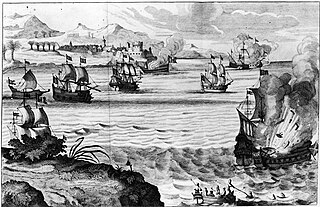
Sir Henry Morgan was a Welsh privateer, plantation owner, and, later, Lieutenant Governor of Jamaica. From his base in Port Royal, Jamaica, he and those under his command raided settlements and shipping ports on the Spanish Main, becoming wealthy as they did so. With the prize money and loot from the raids, Morgan purchased three large sugar plantations on Jamaica.

The Anglo-Spanish War was a conflict between the English Protectorate under Oliver Cromwell, and Spain, between 1654 and 1660. It was caused by commercial rivalry. Each side attacked the other's commercial and colonial interests in various ways such as privateering and naval expeditions. In 1655, an English amphibious expedition invaded Spanish territory in the Caribbean. In 1657, England formed an alliance with France, merging the Anglo–Spanish war with the larger Franco-Spanish War resulting in major land actions that took place in the Spanish Netherlands.
This timeline of the history of piracy in the 1680s is a chronological list of key events involving pirates between 1680 and 1689.

Robert Searle was one of the earliest and most active of the English buccaneers on Jamaica.

Bartholomew Sharp was an English buccaneer and privateer. His career of piracy lasted seven years (1675–1682). In the Caribbean he took several ships, and raided the Gulf of Honduras and Portobelo. He took command of an expedition into the Pacific and spent months raiding settlements on the Pacific Coast of South America including La Serena which he torched in 1680. His flagship, taken at Panama, was the Trinity.
David Marteen was a Dutch privateer and pirate best known for joining Henry Morgan’s raids against Spanish strongholds in present-day Mexico and Nicaragua. He is also the subject of a popular buried treasure legend.
John Morris was an English buccaneer active in the Caribbean during the 1660s and early-1670s. His son, John Morris the Younger, held a command of his own ship during his father's later expeditions against Portobelo and Maracaibo. John Morris the Younger was one of the commanders killed in an explosion during a party on board Henry Morgan's flagship in 1670.

Edward Davis or Davies was an English buccaneer active in the Caribbean during the 1680s and would lead successful raids against Leon and Panama in 1685, the latter considered one of the last major buccaneer raids against a Spanish stronghold. Much of his career was later recorded by writer William Dampier in A New Voyage Round the World (1697).
Manuel Ribeiro Pardal, also known as Manuel Rivero Pardal or Pardel, was a 17th-century Portuguese privateer in Spanish service during the late 1660s and early 1670s.
Laurens Prins, anglicized as Lawrence Prince, was a 17th-century Dutch buccaneer, privateer and an officer under Captain Sir Henry Morgan. He and Major John Morris led one of the columns that raided Panama in 1671.

Edward Mansvelt or Mansfield was a 17th-century Dutch corsair and buccaneer who, at one time, was acknowledged as an informal chieftain of the "Brethren of the Coast". He was the first to organise large scale raids against Spanish settlements, tactics which would be utilised to attack Spanish strongholds by later buccaneers in future years, and held considerable influence in Tortuga and Port Royal. He was widely considered one of the finest buccaneers of his day and, following his death, his position was assumed by his protégé and vice-admiral, Henry Morgan.

Pierre le Picard (1624–1690?) was a 17th-century French buccaneer. He was both an officer to l'Olonnais as well as Sir Henry Morgan, most notably taking part in his raids at Maracaibo and Panama, and may have been one of the first buccaneers to raid shipping on both the Caribbean and Pacific coasts.
Jan Willems, also known as Janke or Yankey Willems, was a 17th-century Dutch buccaneer. Based out of Petit-Goâve, Willems participated in a number of expeditions against the Spanish during the early to mid-1680s with other well-known privateers including Michiel Andrieszoon, Thomas Paine, Laurens de Graaf, Nicholas van Hoorn and Michel de Grammont.
Jelles de Lecat was a Dutch pirate and buccaneer who sailed for and against both the English and Spanish. He served with Henry Morgan and was often called "Yellahs," "Yallahs," or “Captain Yellows.”

Pierre Francois was a mid-17th-century flibustier, or French buccaneer, active in the Caribbean. He is best known for a single attack on a Spanish pearl-diving fleet. His story appears only in Alexandre Exquemelin's History of the Buccaneers and the truth of his account is uncertain.

Edmund Cooke was a merchant captain, buccaneer, and pirate. He is best known for sailing against the Spanish alongside Bartholomew Sharp, John Coxon, Basil Ringrose, Lionel Wafer, and other famous buccaneers. Cooke's flag was red-and-yellow striped and featured a hand holding a sword.
Edward Dempster was a buccaneer and privateer active in the Caribbean. He is best known for his association with Henry Morgan.
George Spurre was an English pirate and buccaneer. He is best known for sacking Campeche and for joining a large buccaneer force which captured Veracruz.

Henry Morgan's Panama expedition also known as the Sack of Panama, was an expedition that took place between 16 December 1670 and 5 March 1671 during the later stage of the Anglo-Spanish War. English privateers and French pirates commanded by notable Buccaneer Henry Morgan launched an attack with an army of 1,400 men with the purpose of capturing the rich Spanish city of Panama off the Pacific coast.

Henry Morgan's raid on Lake Maracaibo, also known as the Sack of Maracaibo and the Battle of Lake Maracaibo, was a military event that took place between 16 March and 21 May 1669 during the latter stage of the Anglo-Spanish War. English privateers commanded by notable Buccaneer Henry Morgan launched an attack with the purpose of raiding Spanish towns along the coastline inside of Lake Maracaibo in the Spanish Province of Venezuela.











